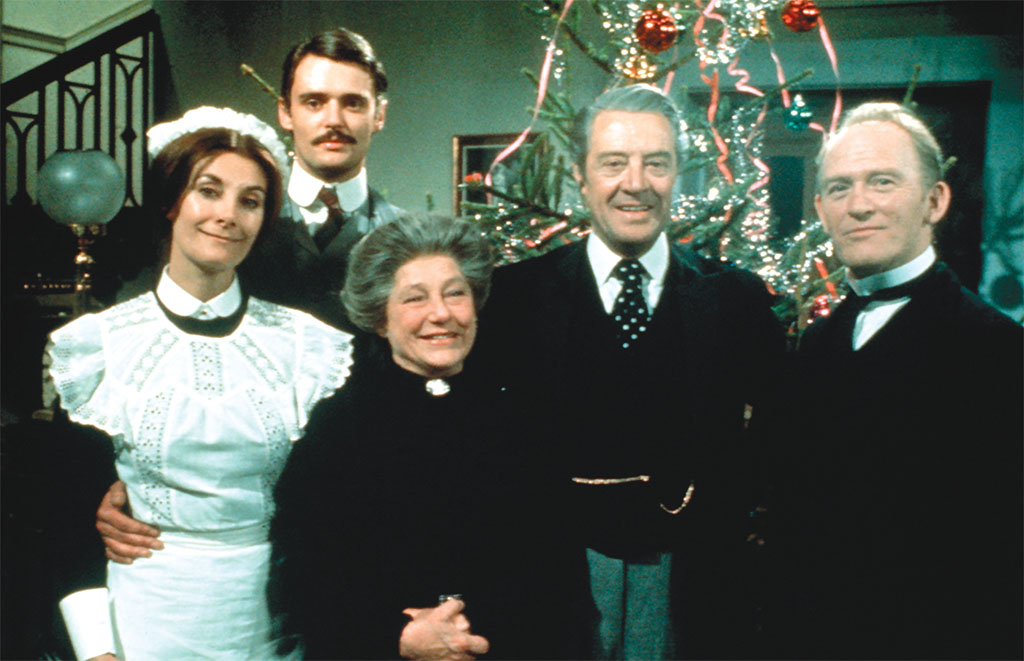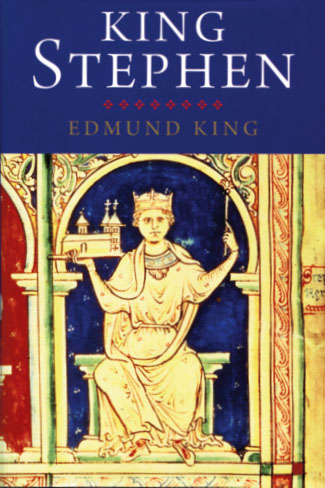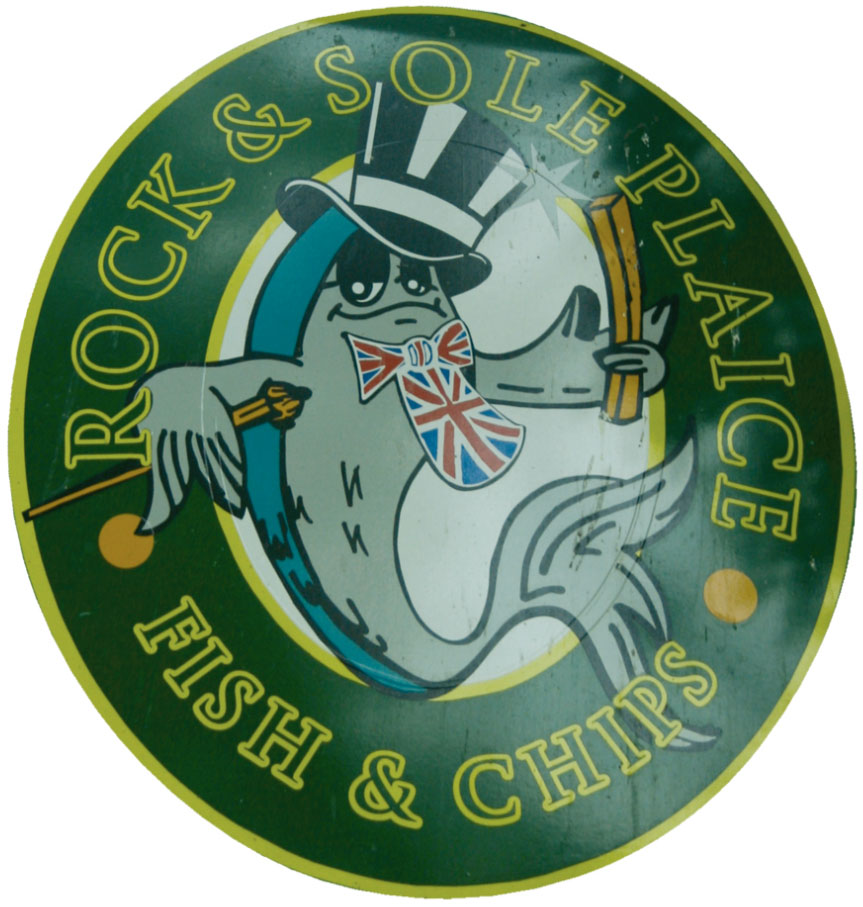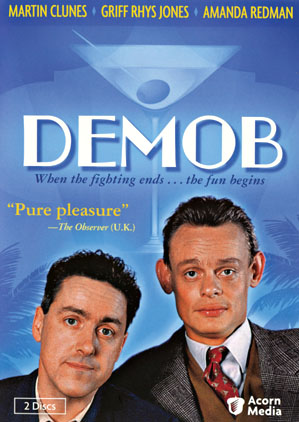
[caption id="BeyondtheBookshelf_img1" align="aligncenter" width="1024"]

COURTESY OF ACORN MEDIA
Being the Belle of the Ball
DVD
[caption id="BeyondtheBookshelf_img2" align="alignright" width="253"]

Love in a Cold Climate, 3-disc set, Acorn Media, Silver Spring, Md., 8 episodes, app. 405 minutes, $59.99
A COLD CLIMATE INDEED. No one pretends that life growing up in the English aristocracy was ever warm and cuddly. British weather can be a little chilly, too.
Judi Dench and Michael Williams headline a star-studded cast as Lord and Lady Alconleigh, presiding over a brood of children (“Hons”) coming of age in the heady years between the wars. Based on the quasi-autobiographical novels of Nancy Mitford, Love in a Cold Climate is the romantic bildungsroman of two close cousins, Linda and Fanny, and their dear friend Polly.
Though their world is perceptibly crumbling at the edges, and often seems more than a little decadent, the players are largely blissfully unaware of the world around them. After all, landed nobility who’ll live all their lives on unearned income don’t make convincing Communists&mdesh;and don’t stay comrades for long.
With the exception of Lady Alconleigh and the eminently sensible and relatively poor Fanny (who marries an Oxford don), most of the principal characters seem delightfully airheaded. In many contexts, that would just be sad. As P.G. Wodehouse showed us masterfully with Bertie Wooster, however, when the airheads are the aristocracy, somehow the results can be great fun. There’s nothing funny about a poor old woman slipping and falling on a banana peel. Give the lady some heft, a fur coat and a surfeit of dignity, however, and we laugh. So does Nancy Mitford, and we can’t help but laugh with her.
Yes, this is the same kind of world readers have been seeing in Downton Abbey. At Alconleigh, however, there are no serious glimpses of the downstairs. Except incidentally, the serving class here is out of sight and silent. Nancy Mitford’s focus is strictly on the extended family and social connections of the upstairs world&mdesh;and in particular on the romantic longings and entanglements of the girls. While the result could be maudlin and saccharine, it isn’t. It’s witty, literate and thoroughly enjoyable, a blend of period romance and social satire at its best.
This older series received critical and popular claim when it was first shown on the BBC and PBS almost 30 years ago. Now, the series has been released on DVD for the first time. It holds up remarkably well&mdesh;much better than many of Acorn’s older releases. For those who love Down ton Abbey, here’s a delightful change of pace that is at once fresh and familiar, and not a cold climate at all.
BOOKS
[caption id="BeyondtheBookshelf_img3" align="alignright" width="264"]

Heretic Queen: Queen Elizabeth I and the Wars of Religion by Susan Ronald, St. Martin’s Press, New York, 368 pages, hardcover, $27.99.
Effectively Steering the Middle Way
’TIS BROADLY KNOWN THAT the first Queen Elizabeth only managed to hang on to her life during the reign of her half-sister Queen Mary by her nerve and her wits. When Mary died, Elizabeth inherited a throne and a kingdom destabilized by religious passions at home and besieged by the political currents fomented by religious wars on the Continent. Those nerves and wits stood Elizabeth in good stead as she steered England’s ship of state for more than 40 years through the shoals of international politics and domestic passions.
While many volumes have been written about Elizabeth and her reign, in Heretic Queen Susan Ronald moves the eyepiece a little closer to Gloriana and her inner circle, focusing specifically on the religious matters themselves and how Elizabeth managed to maintain a middle course for England’s nominally Protestant church.
While championing the Protestant cause, Elizabeth embraced the episcopacy of the Church of England. That was a handful. Mary had left Protestants few and uncomfortable choices. They could reconvert back to the Church of Rome, face the prospect of burning at the stake—or flee. Many Protestant clerics, especially from the Eastern Counties, chose the latter, heading for sanctuary to the centers of Reformation thought—Zurich, Geneva, Heidelberg and the like. When Elizabeth took the crown, they were free to return home. Now schooled in Reformation theology, they returned determined to purify the Church of England of the Catholic vestiges in its worship and ecclesiology. They did not shun the label Puritan.
At the same time, many in England had retained allegiance to the “old religion,” remaining loyal to the Catholic faith and bent on restoring it to national life in England.
Of course, in the 16th century, it never occurred to anyone that folk could actually live together peaceably and respect others’ freedom of conscience. Church was inextricably tied to state. A national church was all that anyone conceived. How Elizabeth managed to suppress the Catholics and hold the Puritan floodtide at bay within the English church, while at the same time navigating the religion-based alliances abroad makes a riveting read. She didn’t manage to make many people happy, but she did maintain her kingdom, her crown and her head, while many about her were losing theirs.
BOOKS
[caption id="BeyondtheBookshelf_img4" align="alignright" width="263"]

London: A Social and Cultural History, 1550-1750 by Robert O. Bucholz and Joseph P. Ward, Cambridge University Press, New York, 415 pages, hardcover, $27.99.
OF THE MAKING OF BOOKS on London, there is no end. From its political history to its architecture, restaurants and eccentric residents, Britain’s incomparable capital city has been poked and prodded by writers from Samuel Johnson to Bill Bryson. No comparable-sized piece of ground on the planet can have mustered—or merited—such a body of words. Of course, there’s a reason for that.
Over a span of 200 years, London underwent a metamorphosis from a small city and minor European court into a wealthy, fashionable cultural and political center of 675,000 people. By 1750, Britain governed large parts of the globe, and London governed Britain—in every aspect of life. How London emerged as the city we recognize today is the story unfolded in London: A Social and Cultural History, 1550-1750.
Don’t be put off by the prosaic academic title. This is a vibrant story, full of twists and turns of fashion, political and social intrigue and interesting characters. In clearly written, anecdotal fashion, Bucholz and Ward paint a vivid picture of the vibrant, growing city, warts and all. Its pages, as its subject, are populated with colorful characters, such as Daniel Defoe, Samuel Pepys, Oliver Cromwell and King Charles II.
Some 50 pages of drawings, prints and maps illustrate the text, and it includes a substantial bibliography. Unhappily, the book lacks an index, which makes it difficult to use as a convenient reference. As an account of how and why London is London, however, this is the best book to come along in a generation.
SOUVENIR ALBUMS
Royal Collection Publications
[caption id="BeyondtheBookshelf_img5" align="aligncenter" width="606"]

Queen Elizabeth II
A Diamond Jubilee Souvenir Album
Jane Roberts
This album charts the Queen’s life from childhood to the present and provides a biography in photographs of the truly remarkable woman it celebrates.
“Marking the 60th anniversary of Her Majesty’s accession to the throne, this official souvenir album of her reign is a beauty. For any of us with a felt affection for the Queen and a desire to have a memento of this historic Jubilee, this album is a treasure indeed.”—British Heritage
“A fascinating spotlight on the monarch’s upbringing.”—Daily Mail
CLOTH $24.95
[caption id="BeyondtheBookshelf_img6" align="aligncenter" width="606"]

Diamonds
A Jubilee Celebration
Edited by Caroline de Guitaut
From jewelry of the highest quality and finest craftsmanship to gemstone-laden tiaras and diamond-encrusted swords, this accessible volume presents a visually stunning selection of diamonds from among the Royal Collection’s awe-inspiring array
CLOTH $24.95
Distributed by the University of Chicago Press
www.press.uchicago.edu
[caption id="BeyondtheBookshelf_img7" align="alignright" width="152"]

London 2012 Hitting the Highlights
THE 30TH SUMMER OLYMPIAD will turn the eyes of the world on London over the next few weeks. As British Heritage readers have been warned, unless you have plans well in place, London is no place to be during the Olympic weeks. From the comfort of a distance and the miracle of modern technology, however, we can all witness the best of Olympic competition with a better view than most in-person spectators will receive. Here is a helpful calendar of the medal rounds in the most popular competitions.
July 27 Opening Ceremony - Olympic Stadium
July 29 - August 4 Swimming - Aquatics Centre
July 31 - August 7 Gymnastics - North Greenwich Arena
August 4-11 Track and Field - Olympic Stadium
August 8, 9 Beach Volleyball - Horse Guards Parade
August 11 Football - Wembley Stadium
August 11, 12 Basketball - North Greenwich Arena
August 11, 12 Volleyball - Earl’s Court
August 12 Closing Ceremony - Olympic Stadium
[caption id="BeyondtheBookshelf_img8" align="aligncenter" width="892"]

CLOCKWISE FROM UPPER LEFT: REUTERS/KAI PFAFFENBACH;GETTY IMAGES; GETTY IMAGES; AFP/GETTY IMAGES; REUTERS/TOBY MELVILLE;GETTY IMAGES





Comments